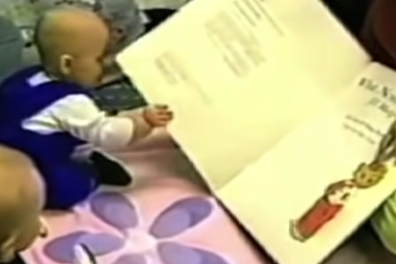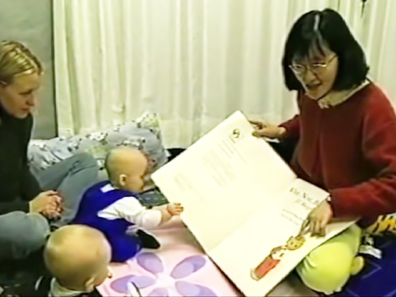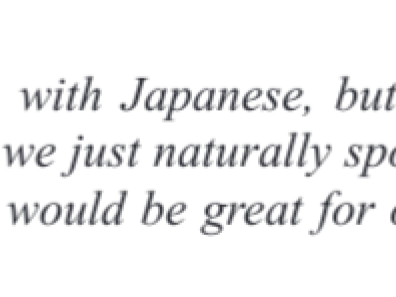Language transmission within the family circle: why, why not and how?

What roles do the actors who make up the family space play in language transmission?
Interest in language transmission leads us to consider the members who make up the family space and their roles within linguistic organization. Parents play an essential role in the child's development and initiate language transmission. Yet children also remain important players within the family space, since they find themselves at the center of linguistic decisions and have the power to influence them.
1. The role of parents in newborn language acquisition and the importance of the family circle
Before discussing language transmission, it is possible to raise the fundamental role of parents, but also of the child's social environment, in the acquisition of language as a tool of communication. Without going into an exhaustive description of a newborn's language development, it seems important to highlight the multiple influences of his or her environment. In the pre-linguistic period, infants become aware of and distinguish the sounds around them. In particular, he is able to recognize human voices by distinguishing sounds produced in his environment. During vocal activity, which can be associated with babbling, the newborn produces units of sound, called phonemes, which are much more varied than those produced by an adult. This phenomenon can be explained by the acquisition of the mother tongue, which involves the appropriation of the suprasegmental features of the language: its prosody, i.e. the rhythm of the language, its intonations, accents and tones. The child goes through a phase of phonetic discrimination to better grasp sounds and distinguish them categorically, as we do as adults. Without digressing, this demonstration of language acquisition in children already shows that, very early on, children become aware of their environment and listen to it attentively. In this sense, the family circle represents a significant space for the constitution and development of language, but also of languages, in children.

Screen from the video "Patricia Kuhl: the linguistic genius of babies"from the TED Talk channel on Youtube. An experiment conducted with newborns concerning their exposure to different input.
Studies dedicated to language acquisition in children show that significant exposure to language, i.e. input, contributes to the development of language reception and production. Language acquisition can only be successful if the child is exposed to interactions that are both regular and dyadic, i.e. interactions that complement each other and are reciprocal. Experiments with children exposed to radio and television have shown that exposure to sound and vision is not enough to initiate a learning process. Human exchange remains essential, and is made up in particular of so-called metalanguage strategies. Perceived as "pragmatic directives" consciously initiated by the parents, they represent a form of support enabling the child to better understand the mechanisms of language. Thus, all information about words, all directives initiated by parents to correct the child, are all kinds of strategies that highlight their active role in the child's language acquisition.
2. The role of parents and the child's social environment in the child's development
A great deal of research of different inclinations (psychological, sociolinguistic, cognitive, acquisitional linguistics) has examined the forms of input provided by parents and their consequences for children's cognitive, identity, language and emotional development. Karen Watson-Gegeo's (2004) work on second-language acquisition, for example, outlines the origins of the cognitive process by which children process information and acquire and use language. In the light of new research, she notes that cognitive abilities are not the result of genetic phenomena, since the human genome cannot contain all the necessary information. Rather, human cognition, and therefore children's cognition, derives from interactions with their environment, which influences them and helps them to develop. Similarly, researcher Jouët, who has studied the process of identity, emphasizes the place of the Other in the construction of the I. In her view, "the identity of the child is the result of his or her environment. According to her, "a person's identity is also composed in otherness, in the affirmation of belonging and hence also of difference, an affirmation that can be seen in customs" (2000: 504). In this, the child is built with and through others, highlighting the major role of the family, as well as the child's social environment, in both cognitive and identity development.
Family language policies, a space for language transmission and maintenance
The family circle represents a necessary field of research and observation for understanding intergenerational language (non)transmission. It is then possible to raise the term "family language policy", which is akin to the linguistic organization governed, consciously or unconsciously, by the actors who make up this space. This organization is of particular interest to researchers because of its direct relationship with the preservation or disappearance of languages, on a family or even global scale. In this way, we can better understand the issues at stake, as well as the relationships between speakers and their language practices. Research into family language policy, although recent, highlights the circulation of languages within the family. They are thus interested in the relationship between speakers and languages, to better understand their dynamics. The questions raised on this subject are vast, and lead us to consider the complexity of each household. Shahzaman Haque's research into family language policy (2019) and intergenerational linguistic transmission (2010) provides food for thought on the place of native languages within migrant families. They raise different notions such as speakers' representations and attitudes to languages, highlighting the various forms of influence linked to social, cultural, identity and even personal context on language transmission.
1. External influence on family language policy
Researchers Abdeljalil Akkari and Nilima Changkakoti (2009), whose interest turned to the relationship between parents and teachers, realized the delicate position of each actor. The migrant family and the school are confronted with different "socializing logics" (2009: 106), and have to negotiate with each other's reality. Their common goal, which is the child's academic success, is often achieved in a tense context due to a mismatch between their approaches and their needs. The school seeks the family's interest in their child's schooling, and looks for a positive, benevolent attitude towards their approach. However, teachers are likely to react differently to the children's family situation, and may adopt a cold attitude to migrant bilingualism.
The early scientific literature dedicated to the study of bilingualism does indeed show a negative image of the native language. Perceived as a disruptive element in the acquisition of the language of the country of residence, negative representations concerning it continue to be conveyed, although new research has deconstructed the idea of a disabling migratory bilingualism. This reticence is forcing families to question or even redefine their linguistic organization in order to better adjust to their children's needs.
2. Internal influence on family language policy
While this example exposes social pressure as an external influencing factor on family language policy, Janice Nakamura's (2019) research raises an internal factor, directly concerning parents. Her work on the development of active bilingualism among children in Japan has led her to consider the notion of Parent's Impact Belief, the belief that parents exercise a form of control over children's language practices. This belief of influence then refers to "their willingness, determination, ability and confidence to play an active role in their children's bilingual development"[1] (2019: 2).
When the parent is convinced that his or her use of a language influences his or her child's language practices, we then speak of Strong Impact Belief. Conversely, when a parent believes that language use has little impact on his or her child's language practices, it's called Weak Impact Belief. The definition of this notion allows us to understand that parents' beliefs and confidence play a decisive role in their linguistic choices and interaction strategies within the family space. The child's language development and the languages that make up his or her language repertoire thus depend on this belief of influence.
Other studies that have also looked at intergenerational language transmission have provided some support for this notion. In particular, Janice Nakamura cites Gabriela Pérez Báez's (2013) research with immigrant parents whose children were born in the United States. She first notes that the parents have chosen not to transmit or maintain their native language within their home. One of the reasons for this choice is their lack of conviction that they can, or should, influence their children's language acquisition. On the other hand, parents feel that their children are unable to understand their native language, derived from the Zapotec languages, and so choose to use another language. This can be seen as a form of discouragement and constraint linked to linguistic choices. Other research, such as that by Roma Chumak-Horbatsch (2008), also points to the low degree of parental influence. If children are not directly linked to language choices, the consideration of dominant languages, and in particular their power, is enough to call into question their ability to influence parents' language practices. Thus, the recognition of English as the dominant language, but also as the language most used with children, leads migrant families to reconsider their linguistic strategies.
Finally, the organization of languages as well as parents' objectives are likely to change in the course of the situations the actors encounter, thus calling into question the possibility of linguistic transmission.
Transmission of languages and experiences
To go further, Janice Nakamura explains that the notion hinges on parents' personal experiences. The families she interviews explain that their desire to pass on English stems from their desire to create a similar environment with their child, but also to prepare them for an environment that is already bilingual:

Corpus excerpt from Janice Nakamura's article "Parent's Impact Belief in Raising Bilingual and Biliterate Children in Japan"(2019) - Interview with Hanna.

Corpus excerpt from Janice Nakamura's article"Parent's Impact Belief in Raising Bilingual and Biliterate Children in Japan" (2019) - Interview with Mel.
Although the belief of influence hinges on other factors, such as spousal support, peer influence or community support, it seems interesting to raise the idea of experience transmission.
The research I've been able to conduct with parents wishing to develop French-English bilingualism in their children raises this idea in particular. The profiles naturally evoke their personal experiences in order to address their linguistic strategies. The testimonies show their desire to accompany their children in their acquisition of English, so that it remains healthy, positive and effective.
Based on each parent's life story, we understand that the difficulties encountered during the acquisition process of their language(s) (feelings of shame, lack of confidence and legitimacy, identity conflict...) encourage parents to pass on different experiences. Conversely, experiences that seemed beneficial to parents (language acquisition in the home environment, usefulness of English...) are considered with children.
Whether it's a strategy of reproduction or avoidance, parents' personal experiences carry an important place in the way languages are transmitted.
What openings?
The study of family language policies and language transmission leads to questions about appropriate survey methods and the identification of research objectives. First of all, to understand the language practices of subjects, the researcher needs to take an interest in the context in which each person evolves. This means accessing subjects' life stories through a biographical approach, leading to a form of collaboration and knowledge sharing. In the light of the research carried out with the subjects, looking back on their experiences has enabled them to re-evaluate their backgrounds, express indignation towards painful memories and, in a way, reconcile themselves with their past. This quasi-therapeutic work also enabled the speakers to reflect on their language practices with their children, and to raise their relatives' interest in them.
This research highlights an interdependent relationship between the fields of sociolinguistics and language didactics. Indeed, while the focus of sociolinguistics remains the subject and his or her use of language, it certainly touches on issues that concern language teaching (Guérin, 2011). On the other hand, in the field of French didactics, the place of the subject remains central, and interest also turns to his or her use of language. In particular, researcher Andréa Young (2016 and 2015) has questioned how language education policies in schools take into account children's "emerging bilingualism". This involves bringing new thinking to bear on caring for and recognizing everyone's language practices, and finally considering better approaches to language learning and teaching.
Song-Uyen LE, Master 2 (M2) in Didactics of Languages (DDL) at Inalco
References
Akkari, A. and Changkakoti, N. 2009. "Parent-teacher relationships". In The International Journal of Family Education, vol. 25, no. 1. p. 103-130.
URL: https://doi.org/10.3917/rief.025.0103
Bernicot, J. 1998. "Language acquisition: Stages and theories". In R. Ghiglione & J.F. Richard (Eds.), Développement et intégration des fonctions cognitives. Cours de Psychologie. Vol. 3 Paris: Dunod. (2nd edition, 1st edition, 1994). p. 420-439. Accessed September 5, 2021.
DOCUMENT: https://slpemad.files.wordpress.com/2015/04/chap1998b.pdf
Billiez, J. 2007. "Être plurilingue, handicap ou atout". In Écarts d'identité, n°111. p. 88-99. Accessed September 1, 2021.
URL: https://maledive.ecml.at/LinkClick.aspx?fileticket=ofhcqwe9cPM=&portal
Guérin, E. 2011. "Sociolinguistics and didactics of French: a necessary interaction". In Le Français aujourd'hui, n° 174. p. 139 - 144. Accessed September 4, 2021.
URL: https://doi.org/10.3917/lfa.174.0139
Ghimenton, A. 2008. "Plurilingual acquisition in a young child from Veneto: a study of language use frequency and pragmatic cues during family interactions" In Linguistics. Université Stendhal - Grenoble III. Accessed September 4, 2021.
URL: https://tel.archives-ouvertes.fr/tel-00466372v2/document
DOCUMENT: http://www.inalco.fr/sites/default/files/asset/document/ghimenton-2008.pdf (pdf / 3.38MB)
Haque, S. 2010. "Transmission of native languages to second generations: the case of the Indian diaspora in northern and western Europe". In Travaux neuchâtelois de linguistique, no. 52. 29-50. Accessed September 4, 2021.
URL: https://hal-inalco.archives-ouvertes.fr/hal-02770065/document
Haque S. et al. 2019. "Family language policy: dynamic issues of language transmission in a migratory context". LINCOM GmbH. p. 18-21. Accessed September 4, 2021.
DOCUMENT: http://www.inalco.fr/sites/default/files/asset/document/haque2019a.pdf (pdf / 713.21KB)
Jouët, J. 2000. "Retour critique sur la sociologie des usages". In Réseaux. Communication - Technologie - Société, vol. 18, n°100. Accessed September 5, 2021.
URL: https://www.persee.fr/doc/reso_0751-7971_2000_num_18_100_2235
LE, Song-Uyen. 2021. "La part d'implication des adultes dans la gestion langagière et identitaire des enfants bi-plurilingues : le cas des parents". Mémoire de Master 2 en Didactique des Langues, under the direction of C. Peigné, INALCO, Paris. 208 pages.
Nakamura, J. 2019. "Parents' Impact Belief in Raising Bilingual and Biliterate Children in Japan". In Psychology of Language and Communication, vol. 23, no. 1. pp. 137 - 161. Accessed September 4, 2021.
URL: https://doi.org/10.2478/plc-2019-0007
Watson-Gegeo, K.A. 2004. "Mind, Language and Epistemology: Toward a Language Socialization Paradigm for SLA". In Modern Language Journal. Accessed September 6, 2021.
URL: https://www.academia.edu/7334780/Mind_Language_and_Epistemology_Toward_a
Young, A., and Mary, L. 2016. "Allowing children's languages to facilitate entry into the language of schooling. Vers un accueil inclusif et des apprentissages porteurs de sens". In La Nouvelle Revue de l'adaptation et de la scolarisation, vol. 73, no. 1. p. 75-94. Accessed September 5, 2021.
URL: https://doi.org/10.3917/nras.073.0075
Video online
Video explaining the pre-linguistic phase of newborns and the influence of languages on its brain [Patricia Kuhl: the linguistic genius of babies]
URL: https://www.youtube.com/watch?v=G2XBIkHW954 - (from 3:46)
Notes
[1] From my own translation. The original quote: "their willingness, determination, ability, and confidence in playing an active role in their children's bilingual development."